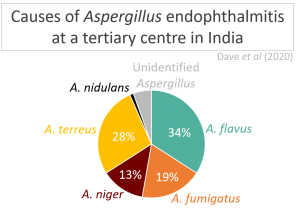Submitted by Aspergillus Administrator on 2 August 2010
Scientists at the Departments of Biology and Chemistry, National University of Ireland Maynooth (NUI Maynooth), led by Professor Sean Doyle, in collaboration with Austrian collaborators, have made a major breakthrough in the area of the molecular microbiology of pathogenic fungi.
They have discovered how a pathogenic fungus protects itself against one of the toxins it can produce to reduce our immune response and so cause infection. The fungus in question is called Aspergillus fumgatus, which can cause severe disease and death in organ transplant patients.
The findings have just been published in the prestigious journal, PLOS Pathogens.
Doyle explained, “The fungus, Aspergillus fumigatus, is the major opportunistic pathogen of immunocompromised individuals, including bone marrow and solid organ transplant patients. We wondered why the organism could produce a molecule, called gliotoxin, which both kills cells and disrupts our immune response, yet had no effect the fungus itself? We found that a single gene called gli-T is present in Aspergillus fumigatus and ultimately acts to ‘inactivate’ gliotoxin. What really surprised us was that although gli-T is just one gene in a cluster of 13, all of which had been thought only to make gliotoxin, it can operate independently of all other genes in the cluster to protect the fungus against gliotoxin. This is quite an unusual phenomenon in fungi, explains a number of recent observations by others working in this research area, and has significant biotechnological potential.”
The work started almost four years ago, as a small component of an inter-institutional PRTLI programme with DCU (Professor Martin Clynes), and an EU programme at Maynooth co-ordinated by Dr Shirley O’Dea. It has involved significant inter-disciplinary and cutting-edge research at the interface of molecular biology and chemistry. For instance, the techniques used to reliably study gene function in Aspergillus fumigatus have only become available in the past few years and Maynooth is one of a small number of laboratories, along with that of collaborator Professor Hubertus Haas (Innsbruck, Austria), where this technology is used. In addition, the work involved the study of proteins of fungal origin, so-called ‘fungal proteomics’.
Maynooth has won competitive funding for the high-throughput instrumentation required for proteomic studies and has significant expertise in this area, not just for the study of human pathogens like Aspergillus fumigatus, but also to investigate plant pathogenic fungi like Armillaria mellea.
As for the future, the researchers intend to commercialise aspects of their findings and a European patent application has been filed on the technology, which has significant potential to improve the quality and yield of diagnostic and therapeutic proteins produced by fungi.
News archives
-
Title
Date




